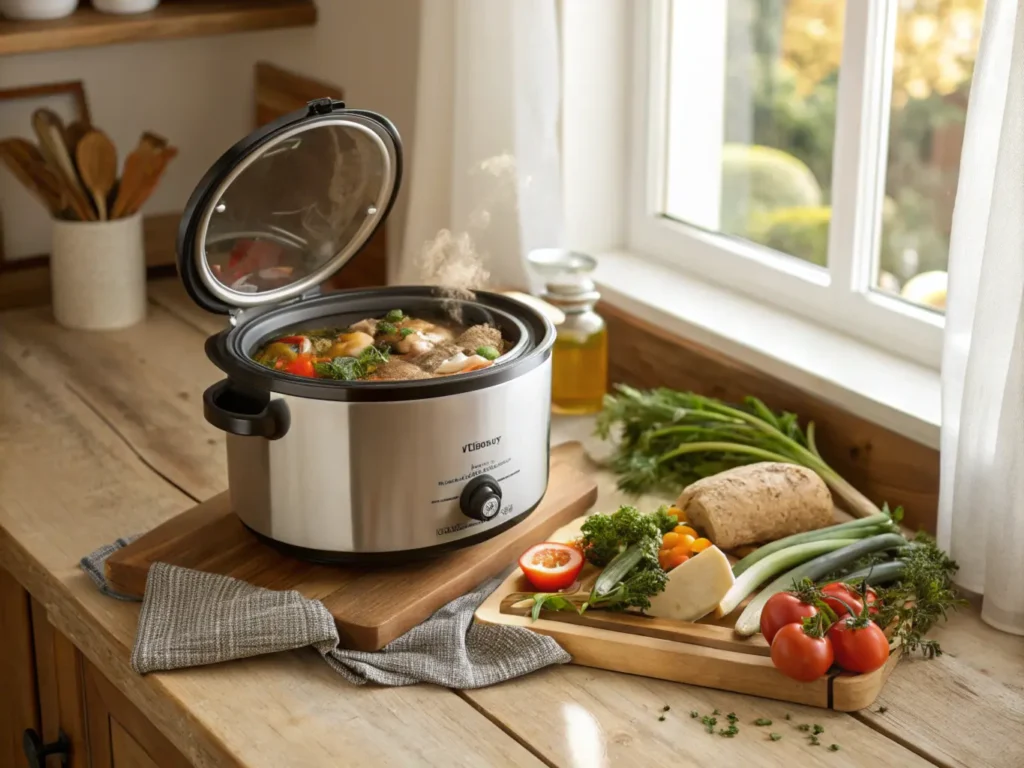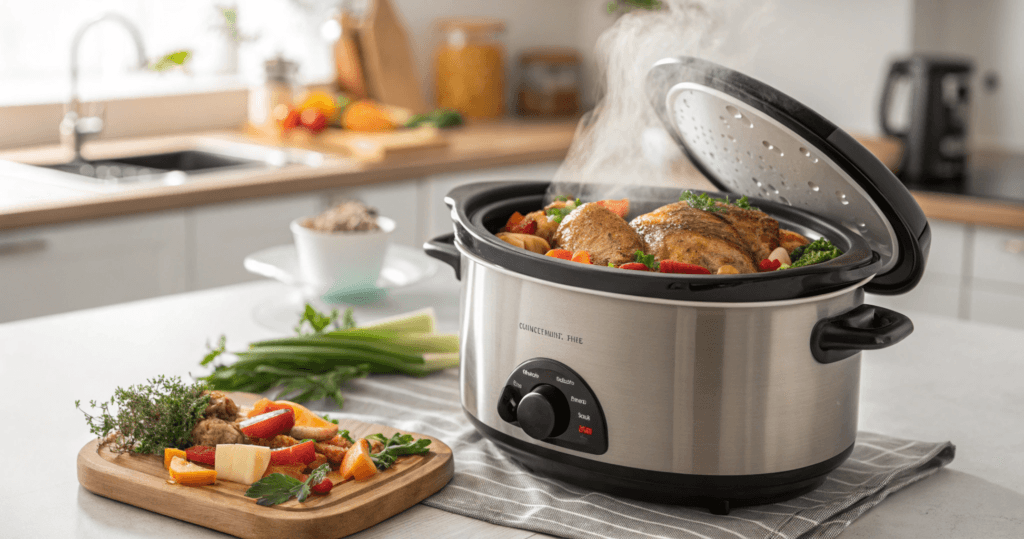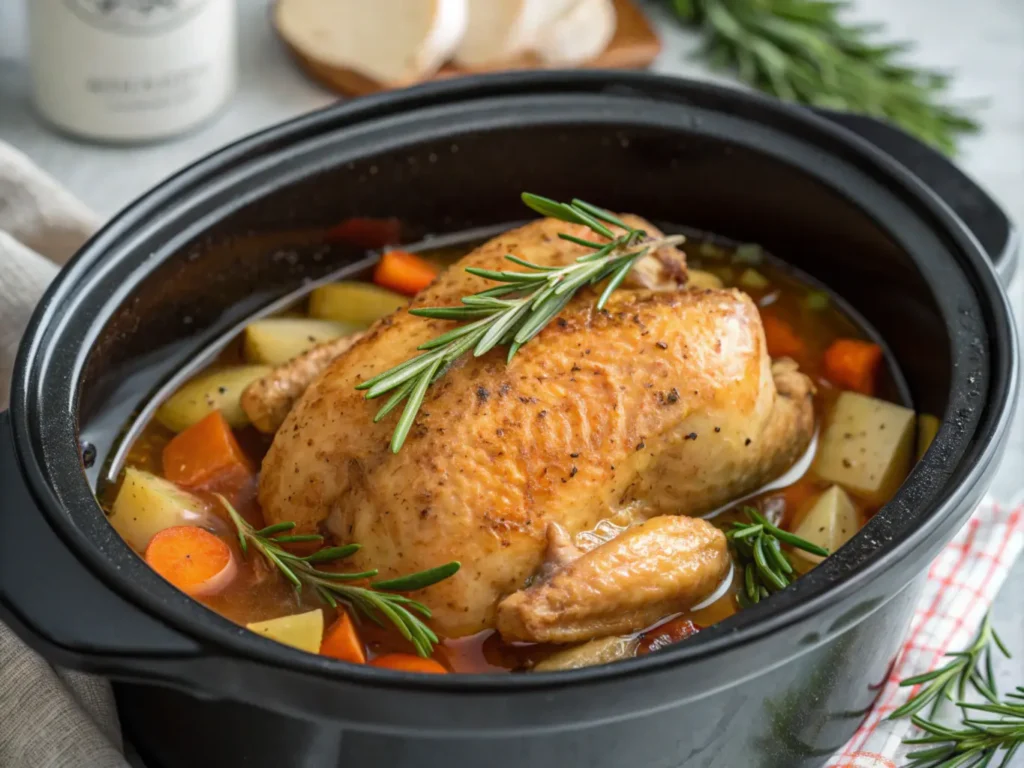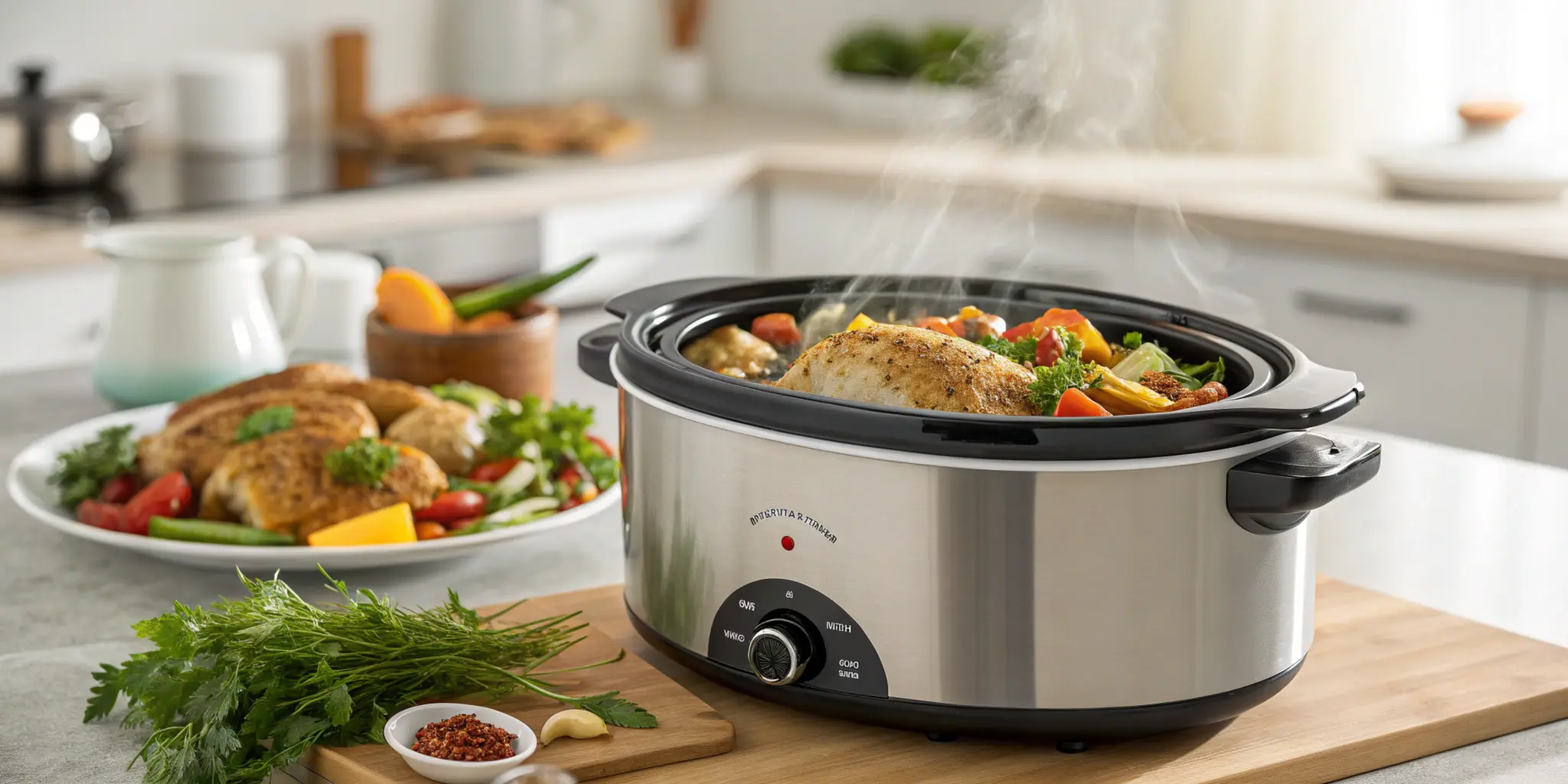Cooking chicken in a crockpot is a lifesaver for busy days. This handy appliance transforms raw ingredients into flavorful meals with minimal effort. However, knowing how long to cook chicken in the crockpot is crucial for safe, tender, and delicious results. This guide breaks it all down for you—from cooking times for various cuts to safety tips and common questions. Let’s get started!
If you’re looking for an easy-to-follow recipe that combines creamy chicken with luscious gravy, don’t miss this Ultimate Crockpot Chicken and Gravy Recipe. It’s the perfect dish to try once you’ve mastered the art of thickening gravy in a crockpot.
What Is a Crockpot?
A crockpot, often called a slow cooker, is a countertop appliance designed to cook food slowly at a low and steady temperature. Its simplicity makes it perfect for people juggling busy schedules, as it requires little attention once started. From soups to stews and even desserts, this versatile tool excels in many ways, but it’s particularly suited for preparing chicken dishes.
Benefits of Using a Crockpot for Cooking Chicken
When it comes to cooking chicken in the crockpot, the benefits are endless. For starters, it ensures consistent cooking without drying out the meat. Unlike traditional stovetop methods, slow cooking locks in moisture, making the chicken juicy and tender. Plus, the hands-off approach means you can prep your meal in the morning and come home to dinner ready and waiting!
But there’s more: crockpots save energy compared to ovens and make clean-up easy, especially if you use liners. Best of all, they’re great for enhancing flavors, as the extended cooking time allows spices and seasonings to seep deep into the meat.

Key Factors Affecting Crockpot Chicken Cooking Times
Cooking chicken in a crockpot seems straightforward, but a variety of factors can significantly impact the time it takes to achieve a perfectly cooked meal. From the type of chicken you use to whether it’s fresh or frozen, each element plays a role. Let’s break it all down so your chicken turns out just right every time.
Type and Cut of Chicken
The type of chicken you use—whether it’s a whole chicken, breasts, thighs, or wings—will directly influence cooking time. Larger cuts like a whole chicken take longer, often requiring 6-8 hours on low heat. On the other hand, smaller cuts like boneless chicken breasts or thighs cook faster, usually in about 4-6 hours. Bone-in pieces tend to need a bit more time as the bones slow heat penetration, whereas boneless cuts finish quicker.
Dark meat, such as thighs and drumsticks, also takes longer than white meat because it contains more connective tissue, which needs extended cooking to break down.
Crockpot Temperature Settings
Crockpots typically come with high and low settings, and these can drastically alter cooking times. If you’re cooking on high, chicken will cook faster, often in 3-4 hours. Conversely, the low setting is ideal for achieving the signature tenderness of slow-cooked chicken, taking 6-8 hours.
While it might be tempting to crank up the heat to speed things up, slow cooking on low produces better results. It allows the chicken to cook evenly and absorb the flavors of your seasonings or sauces.
Quantity of Chicken
The amount of chicken you’re cooking matters too. If your crockpot is full, expect longer cooking times as it takes more heat to cook through the larger volume. Ideally, the crockpot should be two-thirds to three-quarters full for even cooking. Overcrowding it can lead to unevenly cooked chicken, especially in the center.
On the flip side, cooking a smaller amount of chicken means faster cook times, as heat circulates more efficiently. Always adjust your cooking time based on the quantity in your pot.
Starting Temperature of Chicken (Fresh vs. Frozen)
Here’s a common dilemma: fresh or frozen chicken? If you’re starting with frozen chicken, it’ll take longer to cook as the crockpot needs extra time to thaw and then cook the meat. Cooking fresh chicken, however, reduces the overall time by at least an hour or two, depending on the cut.
It’s also important to note that while you can cook frozen chicken in a crockpot, some experts suggest thawing it first for even cooking and food safety. If you do cook from frozen, always check the internal temperature to ensure it’s safe to eat.
By considering these factors, you can adjust your cooking times for consistently great results. Perfect crockpot chicken isn’t just about the time—it’s about understanding these details!
Optimal Cooking Times for Different Chicken Cuts in a Crockpot
When it comes to cooking chicken in a crockpot, the cut of the meat significantly affects the time required. Each cut has unique characteristics, such as size, fat content, and bone structure, which influence how long it takes to cook. Below, we’ll cover the ideal cooking times for popular cuts like whole chicken, chicken breasts, thighs, and wings to help you plan your meals with confidence.

Cooking Times for Chicken Cuts in a Crockpot
| Chicken Cut | Low Setting | High Setting | Notes |
|---|---|---|---|
| Whole Chicken | 6-8 hours | 4-5 hours | Check internal temperature in the thigh; should be 165°F (74°C). |
| Boneless Chicken Breasts | 4-6 hours | 2-3 hours | Add broth or sauce to prevent drying out. |
| Bone-in Chicken Breasts | 5-7 hours | 3-4 hours | Slightly longer due to the bone slowing heat penetration. |
| Chicken Thighs (Boneless) | 6-8 hours | 3-4 hours | Dark meat stays moist; ideal for bold-flavored recipes. |
| Chicken Thighs (Bone-in) | 6-9 hours | 3.5-4.5 hours | Longer cook times for richer flavor. |
| Chicken Wings | 4-5 hours | 2-3 hours | Broil briefly after slow cooking for crispy skin if desired. |
Whole Chicken
Cooking a whole chicken in the crockpot is a popular choice for preparing a hearty and flavorful dish. Since it’s one large piece of meat, it requires a longer cooking time to ensure it’s thoroughly cooked.
- Low setting: 6-8 hours
- High setting: 4-5 hours
For best results, place the chicken breast-side up in the crockpot and avoid lifting the lid during cooking, as this releases heat and increases cooking time. To check for doneness, insert a meat thermometer into the thickest part of the chicken (usually the thigh). It should read 165°F (74°C) for safe consumption.
Pro tip: Adding vegetables like potatoes, carrots, and onions beneath the chicken helps infuse the meat with additional flavor while cooking.
Chicken Breasts
Chicken breasts are a lean option that’s perfect for everything from shredded chicken to salads and sandwiches. However, they can dry out if overcooked, so precise timing is key.
- Low setting: 4-6 hours
- High setting: 2-3 hours
For boneless, skinless chicken breasts, the low setting is ideal for achieving a tender, juicy texture. If you’re using bone-in breasts, they may require an additional 30 minutes to an hour.
To prevent them from drying out, consider adding a liquid like chicken broth or a flavorful marinade. Layering vegetables or placing the breasts under a sauce also helps maintain moisture during the cooking process.
Chicken Thighs
Chicken thighs, whether boneless or bone-in, are a favorite among crockpot enthusiasts due to their rich flavor and higher fat content. They’re more forgiving than chicken breasts, staying moist and tender even with longer cooking times.
- Low setting: 6-8 hours
- High setting: 3-4 hours
Bone-in thighs take slightly longer than boneless, but the difference is minimal. Always ensure the internal temperature reaches 165°F (74°C) for safe eating.
Pro tip: Thighs work exceptionally well in recipes with bold flavors, such as curries, barbecue sauces, or teriyaki glazes.
Chicken Wings
Chicken wings in the crockpot? Absolutely! Slow cooking wings is a fantastic way to create tender, fall-off-the-bone meat before finishing them in the oven or under a broiler for crispy skin.
- Low setting: 4-5 hours
- High setting: 2-3 hours
For added flavor, marinate the wings overnight before placing them in the crockpot. To achieve a crispy texture, transfer the cooked wings to a baking sheet and broil them for a few minutes after slow cooking.

Tips for All Cuts
No matter which cut you choose, here are some universal tips to ensure the best results:
- Always check the internal temperature with a meat thermometer (165°F or 74°C).
- Avoid overfilling the crockpot; this ensures even cooking.
- Resist the urge to open the lid too often, as this disrupts the cooking process.
By understanding the optimal cooking times for each cut of chicken, you’ll master the art of crockpot meals, delivering consistent and delicious results every time!
Food Safety Guidelines for Crockpot Chicken
Cooking chicken in a crockpot is not only convenient but also a great way to prepare meals safely—provided you follow essential food safety practices. From internal temperature checks to proper handling, ensuring your chicken is safe to eat requires attention to detail. Let’s explore the key guidelines to keep your meals safe and delicious.
Importance of Internal Temperature
The most critical factor in determining whether chicken is safe to eat is its internal temperature. For any cut of chicken prepared in a crockpot, the USDA recommends an internal temperature of 165°F (74°C). Using a meat thermometer is the easiest and most accurate way to check this.
Insert the thermometer into the thickest part of the meat without touching the bone. For whole chickens, focus on the thigh area, while for breasts or thighs, check the center of the cut. Don’t assume the chicken is done just because it looks cooked—appearances can be deceiving, especially with slow-cooked meat.
Risks of Undercooking
Undercooked chicken can pose serious health risks, as it may harbor harmful bacteria like Salmonella or Campylobacter. These pathogens are killed when the meat reaches the proper temperature, but consuming chicken that hasn’t been thoroughly cooked could lead to foodborne illnesses. For more information on foodborne bacteria and safe cooking practices, visit Healthline.
Slow cookers heat food gradually, so it’s especially important to ensure that your chicken reaches the correct temperature, particularly if you’re starting with frozen meat. A half-cooked meal isn’t just disappointing—it’s dangerous. Always err on the side of caution and double-check.
Safe Handling and Preparation Practices
Safe handling begins long before you turn on the crockpot. Proper preparation ensures you’re setting the stage for a safe meal. Start by washing your hands thoroughly before and after handling raw chicken. Cross-contamination is a major concern, so use separate cutting boards and utensils for raw meat and other ingredients.
If your recipe calls for frozen chicken, thaw it safely in the refrigerator rather than on the counter to prevent bacterial growth. Alternatively, use the crockpot directly but allow for a longer cooking time.
When adding chicken to the crockpot, make sure it’s surrounded by liquid, such as broth, water, or sauce, for even cooking. And once the meal is done, refrigerate leftovers promptly—don’t leave cooked chicken at room temperature for more than two hours.
By following these food safety guidelines for crockpot chicken, you’ll not only create flavorful meals but also keep your family safe from potential health risks. Safe cooking is smart cooking!
Expert Tips for Cooking Chicken in a Crockpot
Perfecting the art of crockpot chicken requires more than just tossing ingredients into the pot and setting the timer. By using a few tried-and-true techniques, you can ensure your chicken is always flavorful, juicy, and cooked to perfection. Let’s dive into some expert tips that will take your crockpot meals to the next level.
Prepping the Chicken
Preparation is key to successful crockpot cooking. Start by trimming any excess fat from the chicken to prevent an overly greasy dish. While you don’t need to rinse the chicken (as this can spread bacteria), patting it dry with paper towels ensures any seasonings or marinades stick well.
Seasoning is everything when it comes to enhancing flavor. Rub the chicken with your favorite spices, or marinate it for several hours before cooking to allow the flavors to penetrate deeply. For recipes that include vegetables, cutting them into uniform sizes helps ensure even cooking.
If your recipe calls for searing the chicken before adding it to the crockpot, don’t skip this step! Browning the meat locks in juices and adds a deeper, more complex flavor to the dish.
Layering Ingredients
The order in which you layer ingredients in the crockpot matters more than you might think. Start with dense vegetables like potatoes, carrots, and onions on the bottom, as these take longer to cook. The chicken should sit on top of the vegetables to prevent it from becoming soggy and to allow heat to circulate evenly.
When using sauces or broths, pour them over the chicken and vegetables to ensure everything is coated and the flavors meld together during cooking. Avoid overfilling the crockpot—keeping it about two-thirds full ensures even heat distribution and proper cooking.
Avoiding Overcooking
Overcooking is a common mistake that can lead to dry, stringy chicken. While the crockpot’s “set-it-and-forget-it” convenience is tempting, you should still monitor cooking times to avoid leaving the chicken in for too long.
Use a meat thermometer to check the internal temperature of the chicken; once it reaches 165°F (74°C), it’s ready. If your crockpot has a “keep warm” setting, switch to that mode once the chicken is cooked to prevent it from drying out.
For added moisture, consider adding liquids like chicken broth or a savory sauce. These not only enhance the dish but also keep the meat tender and juicy throughout the cooking process.
By following these expert tips for cooking chicken in a crockpot, you can consistently create meals that are not only convenient but also packed with flavor and perfectly cooked every time.
Frequently Asked Questions
Can I Cook Frozen Chicken in the Crockpot?
Yes, you can cook frozen chicken in the crockpot, but it’s important to allow extra time for the meat to thaw and cook thoroughly. The USDA recommends cooking frozen meat at a temperature high enough to ensure it reaches a safe internal temperature of 165°F (74°C). Using the high setting for frozen chicken is generally preferred to bring it to a safe temperature faster, minimizing the time spent in the “danger zone” (40°F–140°F).
However, some experts suggest thawing the chicken first to ensure even cooking, as slow cookers heat food gradually. If you choose to cook frozen chicken, avoid overcrowding the pot and always check the internal temperature with a meat thermometer before serving.
How to Keep Crockpot Chicken Moist?
To keep chicken moist in a crockpot, make sure you add enough liquid, such as broth, water, or a sauce, to the pot. The liquid helps maintain humidity during cooking, preventing the chicken from drying out.
You can also layer the chicken under vegetables or sauces to shield it from direct heat. Avoid overcooking, as extended cooking times can lead to dryness even with added liquid. For lean cuts like chicken breasts, marinate the meat or sear it before slow cooking to lock in moisture. For additional expert tips and techniques on keeping chicken tender and juicy in a crockpot, visit this helpful guide: How to Keep Crockpot Chicken Moist.
Is It Okay to Put Raw Chicken in a Slow Cooker?
Yes, putting raw chicken in a slow cooker is perfectly safe as long as it’s cooked to an internal temperature of 165°F (74°C). The low and steady heat of the crockpot ensures the chicken is cooked safely.
If food safety is your primary concern, starting with thawed chicken instead of frozen is recommended. Some recipes suggest browning the chicken before adding it to the crockpot—not for safety, but to enhance flavor and texture. If you want a detailed guide on food safety and expert tips for cooking raw chicken in a slow cooker, read this comprehensive article: Is It Okay to Put Raw Chicken in a Slow Cooker? Safety & Tips.
How to Thicken Chicken Gravy in a Crockpot?
Thickening gravy in a crockpot is simple and can be done toward the end of the cooking process. Here are a few effective methods:
- Mix a slurry of cornstarch or flour with water, then stir it into the crockpot. Let it cook for another 15-20 minutes to thicken.
- Use instant mashed potato flakes as a thickener for a smoother texture.
- Remove the lid for the last 30 minutes of cooking to allow excess liquid to evaporate naturally.
These methods ensure a rich, satisfying gravy without affecting the flavor of your dish. Now that you’ve learned the basics of how to thicken chicken gravy in a crockpot, why not dive deeper? This detailed guide, How to Thicken Chicken Gravy in a Crockpot: Easy Techniques, offers even more tips to perfect your gravy game.
Should I Brown the Chicken Before Adding to the Slow Cooker?
Browning chicken before adding it to the slow cooker isn’t necessary but can significantly improve the flavor and texture of your dish. Searing the chicken creates a caramelized crust that adds depth to the overall taste.
Additionally, browning the chicken helps to seal in juices, which can keep it moist during the slow cooking process. While it’s an extra step that requires a bit of effort, it’s highly recommended for recipes where flavor and presentation matter most.
Summarizing Crockpot Chicken Cooking Times and Best Practices
Cooking chicken in a crockpot is a simple yet rewarding way to prepare flavorful and tender meals with minimal effort. However, knowing how long can I cook chicken in the crockpot is key to achieving perfect results. The optimal cooking times vary depending on the cut of chicken and the crockpot setting you choose.
For instance, if you’re wondering how long can I cook chicken in the crockpot, whole chickens typically take about 6-8 hours on low or 4-5 hours on high. Smaller cuts, like boneless chicken breasts, cook in 4-6 hours on low or 2-3 hours on high. Bone-in thighs and wings may require slightly more time compared to boneless options. Always ensure the chicken reaches an internal temperature of 165°F (74°C) to guarantee it’s safe to eat.
To achieve the best results, consider prepping your chicken properly, layering ingredients strategically, and keeping an eye on how long can I cook chicken in the crockpot to avoid overcooking. Adding enough liquid and ensuring the crockpot isn’t overcrowded are also essential for even cooking and moisture retention.
Whether you’re preparing a hearty stew or shredded chicken for tacos, mastering how long can I cook chicken in the crockpot ensures delicious, safe, and satisfying meals every time.

